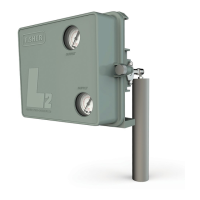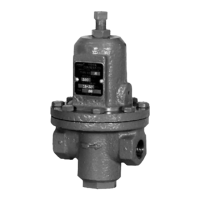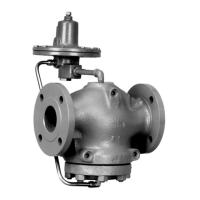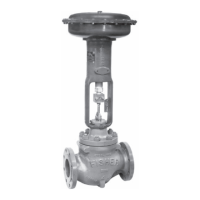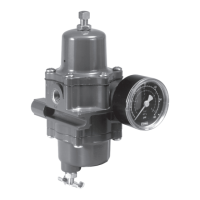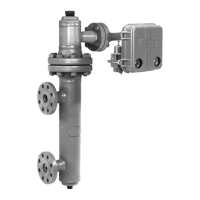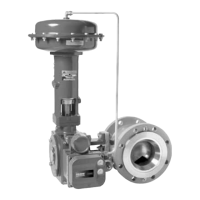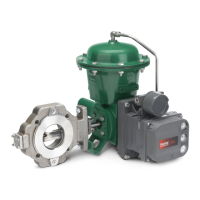4195KA, KB, KC, and KS Controllers
Instruction Manual
Form 5207
April 2007
6-33
D For positive or compound pressure with a
three-capsule stack, loosen the machine screws
(key 139) that secure the travel stop (key 83) to the
mounting plate (key 77). Slide the travel stop until it
is just touching the end of the capsule stack. Tighten
the travel stop mounting screws to lock it into
position. Decrease the input pressure to 100 percent
of the capsular element range and make sure the
capsule stack is not contacting the travel stop (key
83).
D For positive or compound pressure with a
two-capsule stack, loosen the set screw (key 87) in
the travel stop nut (key 86) between the travel stop
(key 83) and the capsule stack. Slide the nut along
the diaphragm capsule extension (key 130) until it
just touches the travel stop (key 83). Tighten the set
screw to lock the travel stop nut in position.
Decrease the input pressure to 100 percent of the
capsular element range and make sure the travel
stop nut is not contacting the travel stop (key 83).
D For vacuum pressure, loosen the set screw
(key 87) in the travel stop nut (key 86) on the end of
the diaphragm capsule extension (key 132 or 133).
The nut is located on the opposite side of the travel
stop (key 83) from the capsule. Slide the nut along
the diaphragm capsule extension until it just touches
the travel stop (key 83). Tighten the set screw to
lock the travel stop nut in position. Decrease the
vacuum to 100 percent of the capsular element
range and make sure the travel stop nut is not
contacting the travel stop (key 83).
2. For the zero stop—perform the following as
appropriate:
D If the lower limit of the capsular element range
is 0 bar (0 psig), adjust the process pressure to 0
bar (0 psig). Slide the zero travel stop nut (key 86)
along the diaphragm assembly extension until it is
approximately 0.4 mm (1/64-inch) away from the
travel stop. Tighten the set screw to lock the travel
stop nut in position.
D If the lower limit of the capsular element range
is other than 0 bar (0 psig), adjust the process
pressure to 5 percent below the capsular element
range lower limit and slide the travel stop nut (key
86) along the diaphragm extension until it just
touches the travel stop (key 83). Tighten the set
screw. Increase the input pressure to the capsular
element range lower limit and make sure the travel
stop nut is not contacting the travel stop (key 83).
Aligning the Capsular Element Linkage
1. Adjust the process pressure to 75 percent of the
capsular element range. The drive flexure (key 79)
should be straight and horizontal. If it is not, proceed
as follows:
a. Loosen the screw on the pivot adjustment arm
on the long pivot clevis assembly (key 78) and
the two screws mounting the drive flexure.
b. Adjust the length of the pivot adjustment arm
so that the drive flexure is parallel to the
centerline of the capsules. Tighten the screw to
set the length of the pivot adjustment arm in that
position.
Note
See figure 6-20. The adjustment arm of
the long pivot clevis assembly is
connected to a shaft that turns on
bushings at each end of the shaft. In
the next step, position the shaft so
that both bushings ‘‘float’’ inside the
bearings and do not rest against the
end of either bearing.
c. Before retightening the drive flexure screws,
hold the long pivot clevis assembly shaft in the
middle of the bushing end play. Be sure neither
bushing is resting against the inside end of either
bearing.
d. Tighten the drive flexure screws to hold the
pivot clevis assembly shaft in position.
2. Set the linearity adjustment screw on the short
pivot clevis assembly so the two arms of the short
pivot clevis assembly are parallel. The linearity
adjustment screw should be near the center of its
slot.
3. Make certain that the process pointer and pointer
subassembly are aligned as shown in figure 6-15. If
not, loosen the zero adjustment locking screw and
adjust the process pointer zero adjustment screw to
align the process pointer and pointer subassembly.
Tighten the zero adjustment locking screw.
4. Adjust the process pressure to 50 percent of the
capsular element range.
5. Loosen the screw on link 5 (key 88) and adjust
the link length so that the pivot arms of the short
pivot clevis assembly (key 89) and the long pivot
clevis assembly (key 78) are parallel. Tighten the
screw.
6. Complete the maintenance calibration by
performing the zero and span adjustments in the
following procedure.
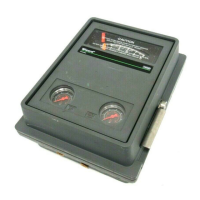
